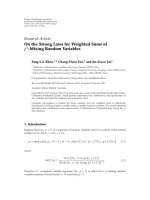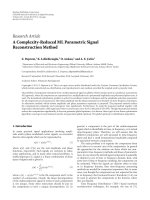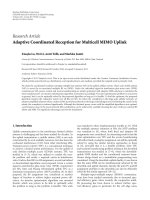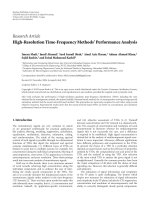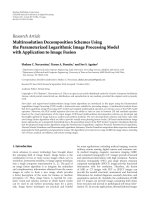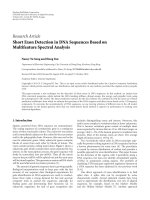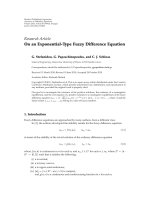Báo cáo hóa học: " Research Article Falling Person Detection Using Multisensor Signal Processing" docx
Bạn đang xem bản rút gọn của tài liệu. Xem và tải ngay bản đầy đủ của tài liệu tại đây (916.73 KB, 7 trang )
Hindawi Publishing Corporation
EURASIP Journal on Advances in Signal Processing
Volume 2008, Article ID 149304, 7 pages
doi:10.1155/2008/149304
Research Article
Falling Person Detec tion Using Multisensor Signal Processing
B. Ugur Toreyin, E. Birey Soyer, Ibrahim Onaran, and A. Enis Cetin
Department of Electrical and Electronics Engineering, Faculty of Engineering, Bilkent University, 06800 Bilkent, Ankara, Turkey
Correspondence should be addressed to B. Ugur Toreyin,
Received 28 February 2007; Accepted 12 September 2007
Recommended by Eric Pauwels
Falls are of the most important problems for frail and elderly people living independently. Early detection of falls is vital to provide
a safe and active lifestyle for elderly. Sound, passive infrared (PIR), and vibration sensors can be placed in a supportive home
environment to provide information about daily activities of an elderly person. In this paper, signals produced by sound, PIR, and
vibration sensors are simultaneously analyzed to detect falls. Hidden Markov models (HMM) are trained for regular and unusual
activities of an elderly person and a pet for each sensor signal. Decisions of HMMs are fused together to reach a final decision.
Copyright © 2008 B. Ugur Toreyin et al. This is an open access article distributed under the Creative Commons Attribution
License, which permits unrestricted use, distribution, and reproduction in any medium, provided the original work is properly
cited.
1. INTRODUCTION
Detection of a falling person in an unsupervised area is a
practical problem with applications in safety and security
areas including supportive home environments. Intelligent
homes will have the capability of monitoring activities of
their occupants and automatically provide assistance to el-
derly people and young children using a multitude of sen-
sors in the near future. Currently used worn sensors include
passive infrared sensors, accelerometers, and pressure pads
[1–5]. However, they may produce false alarms and elderly
people simply forget wearing them very often. Computer
vision-based systems may provide effective and complimen-
tary solutions for fall detection [6]. Although visual systems
are highly successful for detection of a fall, cameras must be
placed in several parts of the house including bathrooms.
Even if the video data is neither stored nor sent to an outside
center for further processing, many people may find such a
practice disturbing.
A combination of passive infrared (PIR), sound, and
vibration sensors provide an efficient solution for fall de-
tection. In this paper, signals produced by these sensors
are simultaneously analyzed to detect falling elderly people.
Sound, PIR, and vibration sensors complement each other.
For example, step sounds are hard to record, if there is a
rug on the floor. However, low cost vibration sensors can be
placed under a rug and they can capture vibrations due to a
walking person or a pet. On the other hand, vibration sensors
cannot be placed on hard floors. Instead, sound sensors can
easily capture a fall on hard floors. PIR sensors easily detect
the motion in a room but they cannot as reliably distinguish
the motion of a pet from the owner as a sound sensor or a
vibration sensor.
In this paper, signals produced by each sensor are pro-
cessed separately in the wavelet domain. It is experimentally
observed that the wavelet transform domain signal process-
ing provides better results than the time-domain signal pro-
cessing because wavelets capture sudden changes in the sig-
nal and ignore stationary parts of the signal. For our pur-
poses, it is important to detect sudden changes rather than
drifts or low frequency variations. Feature parameters are
extracted from wavelet signals in fixed-length data windows
and they are used in hidden Markov models (HMMs) which
are trained according to possible human being and pet activ-
ities including falls.
In Section 2, analysis of the sound sensor signal is pre-
sented. The details of the PIR and vibration sensor data pro-
cessing are described in Sections 3 and 4,respectively.In
Section 5, experimental results are presented.
2. ANALYSIS OF THE SOUND SENSOR SIGNAL
In a typical intelligent supportive home environment, micro-
phones can be placed in rooms and hallways. Audio signals
captured by sound sensors can be used to detect a suddenly
falling person. A typical nine seconds long stumble and fall
2 EURASIP Journal on Advances in Signal Processing
9876543210
Time (s)
Falling sound
−1
−0.8
−0.6
−0.4
−0.2
0
0.2
0.4
0.6
0.8
1
(a)
76543210
Time (s)
Walking sound
−0.4
−0.3
−0.2
−0.1
0
0.1
0.2
0.3
0.4
(b)
Figure 1: (a) Falling and (b) walking person sound recordings.
01.25 2.55
kHz
Figure 2: The subband frequency decomposition of the sound sig-
nal.
recording is shown in Figure 1(a), and step sounds are shown
in Figure 1(b). In this case, the two sound waveforms are
clearly different from each other. However, these waveforms
may “look” similar as the distance from the sensor increases.
For some other cases such as when TV set is on and loud, it
may become even harder to distinguish a sound activity from
the background noise. In addition, almost periodic nature
of step sounds is hard to observe in the time domain signal
but it becomes obvious after wavelet domain signal process-
ing (compare Figures 1(b) and 3(b)). Another problem to be
solved is that sound activity due to a person or a pet should
be distinguished from the background noise.
Significant voice activity is detected using the Teager-
energy-operator-based speech features originally developed
by Jabloun and Cetin [7–9]. The sound data is divided into
1000-sample-long frames and the Teager-energy-based cep-
stral (TEOCEP) [7] feature parameters are obtained using
wavelet domain signal analysis. The sound signal at each
frame is divided into 21 nonuniformly divided subbands
similar to the Bark scale (or mel-scale) giving more emphasis
to low-frequency regions of the sound.
To calculate the TEOCEP feature parameters, a two-
channel wavelet filter bank is used in a tree structure to di-
vide the audio signal s(n) according to the mel-scale as shown
in Figure 2, and 21 wavelet domain subsignals s
1
(n), 1 =
1, , L = 21, are obtained [10–12]. The filter bank of a
biorthogonal wavelet transform is used in the analysis [13].
The lowpass filter has the transfer function
H
l
(z) =
1
2
+
9
32
z
−1
+ z
1
−
1
32
z
−3
+ z
3
,(1)
and the corresponding high-pass filter has the transfer func-
tion
H
h
(z) =
1
2
−
9
32
z
−1
+ z
1
+
1
32
z
−3
+ z
3
. (2)
For every subsignal, the average Teager energy e
l
is estimated
as follows:
e
l
=
1
N
l
N
l
n=1
Ψ
s
l
(n)
, l = 1, , L,(3)
where N
l
is the number of samples in the lth band, and the
Teager energy operator (TEO) is defined as follows:
Ψ
s(n)
= s
2
(n) − s(n +1)s(n − 1). (4)
The TEO-based cepstrum coefficients are obtained after log-
compression and inverse DCT computation as follows:
TC(k)
=
L
l=1
log
e
l
cos
k(l − 0.5)π
L
, k = 1, , N.
(5)
The first 12 TC(k) coefficients are used in the feature vector.
The TEOCEP parameters are fed to the sound activity de-
tector algorithm described in [6] to detect significant sound
activity in a room.
When there is significant sound activity in the room, an-
other feature parameter based on variance of wavelet co-
efficients and zero crossings is computed at each frame.
Wavelet signals for each frame corresponding to the [2.5 kHz,
B. Ugur Toreyin et al. 3
3210
Time (s)
Variance/no. zero crossings of wavelet coefficients
0
1
2
3
4
5
6
×10
−7
(a)
76543210
Time (s)
Variance/no. zero crossings of wavelet coefficients
0
0.5
1.1
1.6
×10
−8
(b)
210
Time (s)
Variance/no. zero crossings of wavelet coefficients
0
0.5
1
1.5
2
2.5
3
3.5
×10
−8
(c)
Figure 3: The ratio of variance of wavelet coefficients σ
2
i
over a number of zero crossings Z
i
, κ
i
= σ
2
i
/Z
i
: variations for (a) falling (1-2 seconds),
(b) walking sounds, and (c) regular speech. Note that κ
i
values for the walking case are an order of magnitude less than falling and regular
speech cases. The threshold T is defined in κ-domain and marked with a line in (b).
5.0 kHz] frequency band are obtained after a single stage
wavelet filterbank. The variance, σ
2
i
of the 500-sample-long
wavelet window and the number of zero crossings, Z
i
,ineach
window i is computed.
A typical step sound is similar to a single syllable
quasiperiodic speech signal. On the other hand, broken glass
and similar sounds are not quasiperiodic in nature. As walk-
ing is quasiperiodic, the zero crossing value, Z
i
, is small com-
pared to noise like sounds. When a person stumbles and falls,
Z
i
decreases whereas the variance of the wavelet signal σ
2
i
increases compared to the background noise. Shouting and
crying for help are voiced sounds and have more energy in
higher frequencies. Therefore, Z
i
decreases when a person
shouts. So we define a feature parameter κ
i
in each window i
as follows:
κ
i
=
σ
2
i
Z
i
,(6)
where the index i indicates the window number. The param-
eter κ
i
takes nonnegative values.
The sound signal due to regular speech has a varying
σ
2
i
-Z
i
characteristic depending on the utterance. When vow-
els are uttered, σ
2
i
increases while Z
i
decreases, which results
in larger κ values compared to consonant utterances. Varia-
tion of κ values versus sample numbers for different cases are
shown in Figure 3.
4 EURASIP Journal on Advances in Signal Processing
S1
a
11
S2
a
22
S3
a
33
a
21
a
12
a
31
a
32
a
23
a
13
Figure 4: Three-state Markov model. Three Markov models are
used to represent speech, walking, and fall sounds.
Activity classification based on sound information is car-
ried out using HMMs. Three three-state Markov models are
used to represent speech, walking, and fall sounds. In Markov
models, S1 corresponds to the background noise or no activ-
ity. If sound activity detector (SAD) indicates that there is no
significant activity, S1 is selected. If SAD detects sound ac-
tivity in a sound frame, then either S2 or S3 is chosen as the
current state according to the value of κ .
A nonnegative threshold value T that is small enough to
reflect the periodicity in step sounds isintroduced in the κ-
domain. In our implementation, we choose T as twice the
standard deviation of κ values corresponding to no-activity
portions of the input signal. If
|κ| <T, we obtain S2; oth-
erwise, S3 is attained as the current state. The classification
performance of HMMs is based on the number of state tran-
sitions rather than specific κ values. Hence choice of T does
not affect the values of the transition probabilities in differ-
ent models as long as it reflects the almost periodic nature of
step sounds.
In order to train HMMs, the state transition probabilities
are estimated from 20 consecutive κ
i
values corresponding to
20 consecutive 500-sample-long wavelet windows covering
125 milliseconds of audio data.
During the classification phase, a state history signal con-
sisting of 20 κ
i
values is estimated from the sound signal
acquired from the audio sensor. This state sequence is fed
to Markov models corresponding to walking, speech, and
falling cases in running windows. The model yielding the
highest probability is determined as the result of the analy-
sis of the sound sensor signal.
The number of transitions between different states is
large for a typical walking sound. Hence the probabilities of
transitions between different states, a
ij
’s, are higher than in-
state transition probabilities, a
ii
’s, for the walking model. On
the other hand, feature parameter κ takeshighvaluesfora
regular speech sound. Consequently, the value of a
33
is higher
than any other transition probabilities in the talking model.
For the fall case, a relatively long no-activity/noise period is
followed by a sudden increase and then a sudden decrease in
κ values. This results in higher a
11
value than any other tran-
sition probabilities. In addition to that, the number of tran-
sitions within, to and from S2, is notably fewer than those of
S1 and S3. The state S2 in the Markov models provides hys-
teresis that prevents sudden transitions from S1 to S3 or vice
versa, which is especially the case for walking.
3. PIR SENSOR DATA PROCESSING
Commercially available PIR sensors produce binary outputs;
however, we capture a continuous amplitude analog signal
indicating the strength of the received signal. The corre-
sponding circuit is shown in Figure 5. The sampling rate is
300 Hz. A typical received signal is shown in Figure 6.
The strength of the received signal from a PIR sensor in-
creases when there is motion due to a hot body within its
viewing range. Therefore, it provides robustness against a
possible confusion between typical voice activity and a fall
analyzed by audio sensors only. Alarms produced by other
sensors should be ignored when there is no motion in a
room. On the other hand, the motion may be due to a pet
or the owner. The PIR sensor data can be used to differen-
tiate between the motion of a human being and an animal.
Typically the PIR signal amplitudes for a person are higher
than the amplitudes due to the motion of a pet as pets are
smaller than human beings for a given distance as shown
in Figure 7. However, a simple amplitude-based classifica-
tion will not work because the IR signal amplitude decreases
with distance. Another distinguishing factor is the speed of
the motion. Pets move faster than human beings. This is re-
flected in the sensor output signal.
There is bias in the PIR sensor output signal, which
changes according to the room temperature. Wavelet trans-
form of the PIR signal removes this bias. Let x[n]beasam-
pled version of the signal coming out of a PIR sensor. Wavelet
coefficients obtained after a single stage subband decom-
position, w[k], corresponding to [75 Hz, 150 Hz] frequency
band information of the original sensor output signal x[n]
are evaluated with the integer arithmetic high-pass filter,
described in Section 2, corresponding to Lagrange wavelets
[13] followed by decimation.
In this case, the wavelet transform coefficients w[k]’s are
directly used as a feature parameter in an HMM-based classi-
fication. If the binary output of the PIR sensor indicates that
there is no motion for the nth sample, then S1 is chosen as
the current state. Similar to Section 2, we define a nonnega-
tive threshold T
p
in the wavelet domain. If there is a motion
for the nth sample and the corresponding wavelet coefficient
satisfies
|w[k]| <T
p
, we obtain state S2; otherwise, state S3
is attained as the current state.
Wavelet signal captures the high frequency information
in the signal. Therefore, we expect that there will be more
transitions occurring between states due to the motion of a
pet.
For the training of the HMMs, similar to the audio sig-
nal processing step, the state transition probabilities for hu-
man being and pet models are estimated from 150 consecu-
tive wavelet coefficients covering a time frame of one second.
During the classification phase, a state history signal con-
sisting of 150 consecutive wavelet coefficients is computed
from the received sensor signal. This state sequence is fed to
the human being and pet models in running windows. The
model yielding highest probability is determined as the result
B. Ugur Toreyin et al. 5
PIR
1
2
3
R1 10K
+
C1
10 μf
R2
100K
R3
10K
C2
+
10 μf
C3.1 μf
R4 1M
3
2
1
+
IC1A
−
IC1 = LM324
PIR
= PIR325
D1-D5
= 1N914
R6
1M
+
C4
10
μf
R5
10K
D1
D2
R7
1M
6
5
−
IC1B
+
7
C5.1 μf
R8 1M
−
IC1C
+
9
10
4
8
D3
−
IC1D
+
D4
14
11
13
12
R9
1M
Binary PIR output
Analog signal output
5-12 volts
Figure 5: The circuit diagram for capturing an analog signal output from a PIR sensor.
of the analysis of PIR sensor data. The output of the sound-
based decision system can be enhanced using the decision
mechanism of the PIR sensor. For example, after a “fall”
alarm is issued by the sound analysis system, there should
not be any activity in the room or the only activity must be
due to a pet. Also, when there is no activity in a room for a
long time or only activity is due to a pet, a warning signal
may be issued to the monitoring agency to check the elderly
person.
4. VIBRATION SENSOR DATA PROCESSING
When there is a rug on the floor, it is very hard to capture any
sound in a room. On the other hand, vibration sensors can be
placed under the rug and vibration signals can be recorded. A
typical output of a vibration sensor corresponding to a walk-
ing person is shown in Figure 8.
The peak in the signal is due to the pressure applied by a
foot. In this study, a low-cost vibration sensor, ACH-01 man-
ufactured by Measurement Specialties Inc., is used. It is ob-
served that this sensor can capture the force applied by a foot
or a falling person’s body within an area of 25 cm
2
. The rug
used in our experiments has a thickness of 0.5 cm. Therefore,
an array of sensors should be placed under a rug to cover the
entire activity in a room.
When a person falls or sits on the floor, a multitude of
sensors produces significant sensor outputs. In addition, the
duration of sensor outputs is longer than a typical output
due to a step, as shown in Figure 9.Moreover,vibrationsen-
sors can be placed under a mat or a couch to alarm for long-
lasting inactivity.
A vibration signal due to a fall can be easily distinguished
from a signal due to a step pressure by simply monitoring the
duration of sensor outputs. In addition, several neighboring
sensors produce output signals significantly larger in ampli-
876543210
Time (s)
PIR output
0
50
100
150
200
250
Figure 6: A typical PIR sensor output sampled at 300 Hz with 8 bit
quantization when there is no activity in a room.
tude than background noise level at the same time during a
fall.
5. EXPERIMENTAL RESULTS
Models for sound and PIR sensor types are trained with four
two-minute-long recordings of walking, falling, and speech
signals of a single person and random activities of a pet.
Falling detection results due to sound sensor outputs are
compared with those which, when combined with the PIR
sensor output, are presented in Ta bl e 1. Fusion of decisions
from different sensors is realized by utilizing a logical “and”
operation.
6 EURASIP Journal on Advances in Signal Processing
543210
Time (s)
PIR output for a human being
0
50
100
150
200
250
(a)
543210
Time (s)
PIR output for a pet
0
50
100
150
200
250
(b)
Figure 7: PIR sensor output signals recorded at a distance of 2 m for (a) a human being, and (b) a pet.
Table 1: Detection results and false alarms for 163-test recordings.
Audio signal
content
No. of
Recordings
No. of recordings in which a “fall” is detected No. of recordings in which “false alarms” are issued
Using audio Using both audio Using audio Using both audio
data only and PIR data data only and PIR data
Walking +
Speech
16
7070
Speech
55
19 0 19 0
Walking
53
4040
Falling
39
39 39 00
3210
Time (s)
Vibration sensor output for walking
−60
−40
−20
0
20
40
60
(mV)
Figure 8: Vibration sensor output signal for a walking person.
A total of 163 recordings containing various activities are
used for testing; 16 of the recordings contain both speech and
step sounds, 55 contain speech without any motion, 53 con-
tain step sounds, and 39 contain falling. When there is speech
sound only or speech sound along with step sounds in the
recordings, the system issues false alarms if only audio signal
is used for the “fall” decision, as shown in the third and fifth
10.750.50.250
Time (s)
Vibration sensor output for falling
−60
−40
−20
0
20
40
60
(mV)
0.65 s
Figure 9: Vibration sensor output signal for a fall. The duration of
a typical fall signal lasts more than 0.5 seconds.
columns of the table. It also issues alarms for recordings con-
taining only walking sound. Last column of the table shows
that false alarms are eliminated with the incorporation of the
PIR sensor output signal in the decision.
This table does not include any experiments with a vibra-
tion sensor, but it is experimentally observed that the dura-
tion of a typical fall signal lasts more than 0.5 seconds. This is
B. Ugur Toreyin et al. 7
clearly larger than a step signal. Hence a vibration signal due
to a fall and a signal due to step pressure are easily differen-
tiable by just analyzing the duration of the sensor outputs.
6. CONCLUSION
In this paper, a method for detecting a fall inside an in-
telligent environment/building equipped with multitude of
sound, vibration, and PIR sensors is proposed. Wavelet-
based features are extracted from raw sensor outputs and are
fed to a TEO-based sound activity detector. Similarly, PIR
sensor outputs are also processed and sensor recordings con-
taining various human and pet motions are used for training
the HMMs corresponding to different activities including a
fall. Vibration sensors are also used to detect human activity
in rooms covered with rugs. Classification outputs from all
sensors are fused together to reach a final decision.
The proposed multiple sensor system may be used as a
substitute for camera-based monitoring systems and com-
plimentary solution for wearable systems. It can be used in
cooperation with a wearable sensor and a push-button type
call system. The proposed system can be further improved
to handle false alarm sources like barking dogs, slamming
doors, vacuum cleaning, and so forth. This can be achieved
by training models similar to ones defined in Section 2.An-
other possible false alarm scenario is when a person inten-
tionally sits on the floor and wiggles. If there is a false alarm,
then he or she can simply cancel it using his/her wearable
call device. It may also be used to increase the robustness of
camera-based systems in an intelligent building.
ACKNOWLEDGMENTS
This work is supported in part by the Scientific and Technical
Research Council of Turkey, TUBITAK Grant nos. EEEAG-
105E065 and SANTEZ-105E121, and the European Com-
mission with Grant no. FP6-507752 MUSCLE NoE project.
Authors are grateful to Ergul family and their pet Sutlac for
helping in recording PIR data.
REFERENCES
[1] N. M. Barnes, N. H. Edwards, D. A. D. Rose, and P. Gar-
ner, “Lifestyle monitoring: technology for supported indepen-
dence,” Computing & Control Engineering Journal, vol. 9, no. 4,
pp. 169–174, 1998.
[2] S. Bonner, “Assisted interactive dwelling house: edinvar hous-
ing association smart technology demonstrator and evalua-
tion site,” in Improving the Quality of Life for the European
Citizen, Proceedings of the 3rd TIDE Congress, pp. 396–400,
Helsinki, Finland, June 1998.
[3] S.J.McKenna,F.Marquis-Faulkes,P.Gregor,andA.F.Newell,
“Scenario-based drama as a tool for investigating user re-
quirements with application to home monitoring for elderly-
people,” in Proceedings of the 10th International Conference on
Human-Computer Interaction (HCI ’03), pp. 512–516, Crete,
Greece, June 2003.
[4] H. Nait-Charif and S. J. McKenna, “Activity summarisation
and fall detection in a supportive home environment,” in Pro-
ceedings of the 17th International Conference on Pattern Recog-
nition (ICPR ’04), vol. 4, pp. 323–326, Cambridge, UK, August
2004.
[5] W. P. Goforth, “Multi-event notification system for monitor-
ing critical pressure points on persons with diminished sensa-
tion of the feet,” US Patent No. 4647918, March 1985.
[6] B. U. Toreyin, Y. Dedeo
˘
glu, and A. E. Cetin, “HMM based
falling person detection using both audio and video,” in Pro-
ceedings of the International Workshop on Computer Vision in
Human-Computer Interaction (ICCV-HCI ’05), vol. 3766 of
Lecture Notes in Computer Scie nce, pp. 211–220, Springer, Bei-
jing, China, October 2005.
[7] F. Jabloun and A. E. Cetin, “The teager energy based fea-
ture parameters for robust speech recognition in car noise,”
in Proceedings of IEEE International Conference on Acoustics,
Speech, and Signal Processing (ICASSP ’99), vol. 1, pp. 273–276,
Phoenix, Ariz, USA, March 1999.
[8] D. Dimitriadis, P. Maragos, and A. Potamianos, “Robust AM-
FM features for speech recognition,” IEEE Signal Processing
Letters, vol. 12, no. 9, pp. 621–624, 2005.
[9] S H. Chen and J F. Wang, “A wavelet-based voice activity de-
tection algorithm in noisy environments,” in Proceedings of the
9th International Conference on Electronics, Circuits and Sys-
tems (ICECS ’02), vol. 3, pp. 995–998, Dubrovnik, Yugoslavia,
September 2002.
[10] E. Erzin, A. E. Cetin, and Y. Yardimci, “Subband analysis for
robust speech recognition in the presence of car noise,” in Pro-
ceedings of IEEE International Conference on Acoustics, Speech,
and Signal Processing (ICASSP ’95), vol. 1, pp. 417–420, De-
troit, Mich, USA, May 1995.
[11] R. Sarikaya, B. L. Pellom, and J. H Hansen, “Wavelet packet
transform features with application to speaker identification,”
in Proceedings of the 3rd IEEE Nordic Signal Processing Sympo-
sium (NORSIG ’98), pp. 81–84, Vigsø, Denmark, June 1998.
[12] R. Sarikaya and J. N. Gowdy, “Subband based classification
of speech under stress,” in Proceedings of IEEE International
Conference on Acoustics, Speech, and Signal Processing (ICASSP
’98), vol. 1, pp. 569–572, Seattler, Wash, USA, May 1998.
[13] C. W. Kim, R. Ansari, and A. E. Cetin, “A class of linear-phase
regular biorthogonal wavelets,” in Proceedings of IEEE Inter-
national Conference on Acoustics, Speech, and Signal Processing
(ICASSP ’92), vol. 4, pp. 673–676, San Francisco, Calif, USA,
March 1992.

